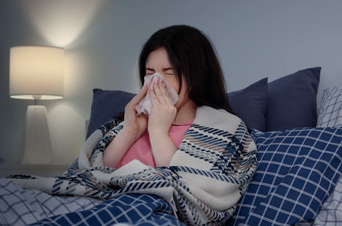
A sound sleep is needed for rejuvenating the mind and body after hectic schedules we all get engrossed with on an everyday basis. The fast-paced life, exhausting work schedules, and rigorous day ins and day outs call for a restful night’s sleep to regain the stamina for a productive tomorrow.
However, this may not seem to be easy and restful for many, for certain conditions cause queasiness during sleep.
Nocturnal means anything occurring at night, hypoxemia is a state of lack of oxygen. Nocturnal hypoxemia is a decrease in the oxygen level of blood during night. The partial decrease may cause an abrupt sense of uneasiness during sleep.
Nocturnal Hypoxemia—In Depth
Nocturnal Hypoxemia is a medical illness that people are unaware of in most cases. It may not only massively affect the wellbeing of a person but may also have a prolonged effect that is concerning.
A healthy level of oxygen in the blood ranges from 95% to 100% during the active hours of the day. Perhaps, an extremely low level of oxygen during the night may cause nocturnal hypoxemia. In some cases, the reduction of oxygen level may reach to an unacceptable extent. Hence, the underlying causes, effects, diagnosis, and treatment should be considered as soon as possible.
Oxygen is crucial as it travels through the blood to different parts, organs, and tissues of the body making the system active to work. Airflow and blood flow are acute to transfer the oxygen adequately. Therefore, sometimes both lung diseases and heart diseases can contribute to nocturnal hypoxemia.
The intensity of this condition may lead to mild and tractable symptoms in some cases. While in other severe cases, it may be fatal too. Also, a prolonged nocturnal hypoxemia may sometimes be referred to as a “chronic respiratory failure.”
What Are Some Common Symptoms of Nocturnal Hypoxemia?
Tractable symptoms of nocturnal hypoxemia such as rapid heart rate, fast breathing, headache, shortness of breath, perplexed requires the same amount of attention as those with intense symptoms.
For a deeper dig, the lung and cardiovascular systems are the two main systems transferring oxygen to the rest of the body. Hence, any disease affecting them inversely affects nocturnal hypoxemia. Moreover, infections that affect the lungs such as COVID-19 or pneumonia may add to the restless hypoxemia as well.
Persistent restless sleep or people suffering from sleep apnea may also experience intermittent nocturnal hypoxemia. It’s a state where the oxygen levels of the blood stay consistently between the lower and normal levels.
Some Elaborated Common Symptoms of Nocturnal Hypoxemia:
- Headaches; constant morning headaches and daytime drowsiness even after night’s sleep is one of the common symptoms of nocturnal hypoxemia.
- Bewildered State; staying in a state of confusion, having no direction or motivation could also be counted as one the most common symptoms of hypoxemia.
- Shortness of Breath; a conscious effort exerted to inhale, and exhale can be deemed as shortness of breath. This may be caused due to some medical conditions as well and can also be the symptom of a few.
- Fast Breathing; when you breathe unusually more times within a minute is ‘tachypnea.’ It can be due to asthma, anxiety, lung disease or even heart disease.
- Coughing or Wheezing; the interlinked relationship of coughing and wheezing with hypoxemia is comprehensive. These can be the symptoms of lung disease or chronic respiratory disease like COPD.
Cause of Nocturnal Hypoxemia
What can potentially cause hypoxemia? To answer this, one thing should clear the air at the utmost. Anything that causes a hurdle and affects the exchange of oxygen and carbon dioxide in the blood may simply cause hypoxemia.
Hypoxemia can be caused by both an underlying disease of lung and heart or may be certain medications taken for the treatment. Other than that, being at high altitudes can also cause nocturnal hypoxemia, which is why you feel breathless in mountains.
Some common causes include:
- Anemia; a state where there isn’t enough healthy RBC count to carry oxygen. RBC carries oxygen throughout your body, inadequate count may result in hypoxemia.
- Asthma; affecting more than 25 million people in US currently, this is a condition where the lungs get affected, making your airways narrower. It’s an ongoing condition that can be treated with medications.
- Bronchitis; the airways connecting to your lungs get inflamed causing severe cough as the body tries to get rid of the mucus. Chronic bronchitis can be managed as it does not go away that easily while acute bronchitis goes away within a week or two.
- Acute Respiratory Distress Syndrome; the buildup of fluid causes lack of air, ultimately resulting in lack of oxygen in the blood. This fluid does not let the lungs work properly.
- Chronic Obstructive Pulmonary Disease; is a single medical term referring to those group of diseases that block the airways and obstruct the lungs to freely inhale oxygen and exhale carbon dioxide.
- Sleep Apnea; breathing is obstructed multiple times as the person snores because of numerous reasons. You might experience abrupt breathing, or the breathing may stop and start suddenly.
- Pneumonia; inflammation of one or both lungs is referred to as pneumonia. It may cause a cough, shortness of breath or even fast breathing.
- Congenital Heart Disease; the inappropriate structure of the heart at the time of birth is known as congenital heart disease. The type of defect and the severity decides the treatment.
- Cystic Fibrosis; is a disease that affects the lungs—the protein present in organs and tissues does not work the same as it used to. As a result of it, the body starts developing mucus that narrows the airways.
Now that we have sunk deeper into the causes and symptoms, you might be pondering over the diagnosis and treatment.
What Are the Ways to Diagnose Nocturnal Hypoxemia?
There are multiple ways for the diagnosis of Nocturnal hypoxemia, some popular ones are listed below.
Continuous Pulse Oximetry; it’s a small device worn on the finger that monitors oxygen levels in blood during night.
Arterial Blood Gas Test; blood sample is withdrawn to measure the oxygen levels in the blood.
Oxygen Desaturation Index; shows how the oxygen levels drop while sleeping.
Sleep stages; the details of interrupted sleep and arousals can also give a pattern to study, where the experts can derive why there are low oxygen levels in the blood.
Six Minute Walk Test; this test can be taken to evaluate the lungs and heart, the experts may ask you to walk flat for 6 minutes. Determining the exertion level would give them insight on oxygen levels too.
A physical examination can be done to see the wellness of lungs and heart, furthermore the physician may also look for other signs such as the bluish color of skin, lips, fingertips or nailbed.
Treatment for Nocturnal Hypoxemia
While we studied the causes, symptoms, and diagnosis—it is significant to understand the treatment that can be considered and managed before consulting an expert. However, it is recommended to consult a certified expert in severe cases.
Several routes can be taken. Some lifestyle changes can help cope with it too. Medicinal therapies play an integral part as well. Nonetheless, it’s best to prevent any such thing promoting hypoxemia and nipping the plant in the bud can’t be well-explained!
It’s imperative that the expert look for the underlying cause, providing a complete plan for its treatment. In addition to this, the symptoms should be taken care of. In rare cases, the healthcare provider may recommend oxygen supplements. Perhaps they may not work for everyone and it’s best to discuss the advantages and disadvantages with the consultant.
- Additional therapies and medicinal route treating the underlying cause may include;
- Inhalers or steroids for people with chronic lung diseases
- Medicines treating the excess fluid in the lungs
- To keep the airways open, experts may suggest either CPAP or sleep apnea positional belts or maybe finger devices that could monitor and help the intensity of sleep apnea.
- One should always avoid the positions that boosts oxygen desaturation
Maintaining healthy diet with greens and promoting good sleep hygiene can also be counted in foster sound sleep and oxygenation
Final Thoughts
It’s critical to know the signs, symptoms, and causes of nighttime hypoxemia. Preventing it and improving the situation through lifestyle changes is encouraged. However, in case of severity and emergency seek medical assistance the soonest.
Hypoxemia and low oxygen levels may have adverse effects on your health. Specific physical conditions and living habits may advocate the intensity of hypoxemia. Monitoring the condition and seeking evaluation is recommended as soon as possible to avoid prolonged sickness and improve overall quality of health!

